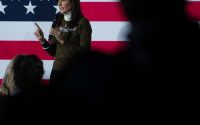Federal Officials Crack Down on Funny Highway Warnings
In recent years, drivers across the country have chuckled (or groaned) at the humorous safety messages that have popped up on America’s highways.
In Massachusetts, there was the inevitable play on the Boston accent: “Changing lanes? Use Yah Blinkah.”
Iowa’s Department of Transportation tried out: “Texting & Driving? Oh Cell No!”
New Jersey paid tribute to Bruce Springsteen, warning drivers: “Slow Down. This Ain’t Thunder Road.”
But federal officials say some of the attempts at humor have gone too far and could be distracting or misunderstood.
In the latest edition of the federal standards for highway signs, published in December, officials warned that messages “with obscure or secondary meanings, such as those with popular culture references” or those that are “intended to be humorous,” should not be used.
The standards do not impose an outright ban on all humor or pop-culture references in highway signs, the Federal Highway Administration said in a statement on Wednesday. But they recommend that officials avoid messages “that may confuse or distract drivers.”
State and local officials should “use good judgment,” the statement said, based on longstanding principles that recommend that highway signs “fulfill a need; command attention; convey a clear, simple message; command respect; and provide adequate time for proper response.”
The federal guidance, reported by The Wall Street Journal, was a blow to state officials who have had fun moonlighting as comedy writers in an attempt to grab the attention of drivers.
Paul Katool, a spokesman for the Mississippi Department of Transportation, is part of a group of employees who bat around ideas every month for funny highway signs, riffing on movies, pop music and upcoming holidays.
One sign that drew widespread attention in Mississippi referred to the lyrics of the hit Taylor Swift song “Anti-Hero”: “Texting and Driving? Say It: I’m the Problem. It’s Me.” Another popular one, Mr. Katool said, referred to the “Star Wars” television show “The Mandalorian,” declaring: “Baby Yoda Uses the Force But Still Needs a Car Seat.”
Not every sign is a runaway hit, Mr. Katool acknowledged. When the movie “Barbie” came out last year, the department urged drivers not to text with the message: “Be a Doll, Use Your Accessories at Home.”
“It was popular,” Mr. Katool said. “It wasn’t super viral.”
Still, he said, humorous signs are “great conversation starters.”
“There’s only so many ways you can say, ‘Don’t text and drive,’” Mr. Katool said. “People tune you out.”
Maine’s transportation department held a clever-sign contest that drew nearly 2,000 entries. One of the winners urged drivers to slow down in winter, declaring, “Little Known Fact: Snow Is Really Slippery.”
“By even having this discussion, MaineDOT believes the signs are meeting the purpose of promoting safety,” Paul Merrill, a spokesman for the department, said in a statement on Wednesday. “We will continue posting our messages and hope the federal government is willing to have more conversations on this topic.”
A 2020 study commissioned by the Virginia Department of Transportation found that “messages about distracted driving, messages that include humor, and messages that use word play and rhymes rank high among multiple measures of effectiveness” in promoting safer driving.
The study recommended using lighthearted signs but targeting messages more narrowly. Signs that use wordplay and rhyming are more effective than those that trade in sports or pop-culture references, it said.
But a 2022 study, funded by the Governors Highway Safety Association and the National Highway Traffic Safety Administration, found that a “significant proportion” of drivers did not understand safety messages that included humor, wit or pop-culture references. That study recommended that highway signs not use humor and that messages be limited to 16 words or numbers.
Richard A. Davey, the president of New York City Transit, said that humorous safety messages can “break through the noise.” When he was secretary of the Massachusetts Department of Transportation in 2014, the “Use Yah Blinkah” highway message got a lot of positive attention from Boston drivers and the local news media, he said.
“I think the local flavor for safety messages is important,” Mr. Davey said. “What works in Wyoming is going to be different in Massachusetts.”
New Jersey has a tradition of using humorous signs like: “We’ll be blunt, don’t drive high,” and “Get your head out of your apps.” However, the state has been warned by federal officials that such messages can be distracting.
“Our goal is always to create attention to safety and that’s what these signs are about,” said Steve Schapiro, a spokesman for the New Jersey Department of Transportation. “It’s about making sure people read them, remember them, and drive safely.”
Still, he said, New Jersey would follow the federal guidance and “be mindful of the kinds of messages we put up, keeping them safety centered.”


